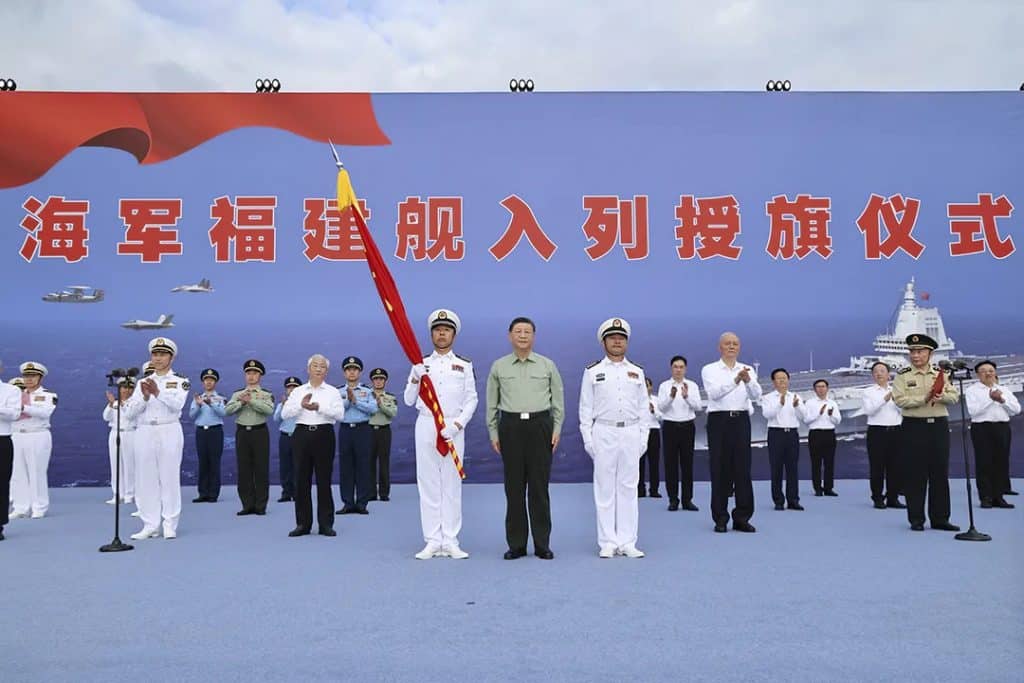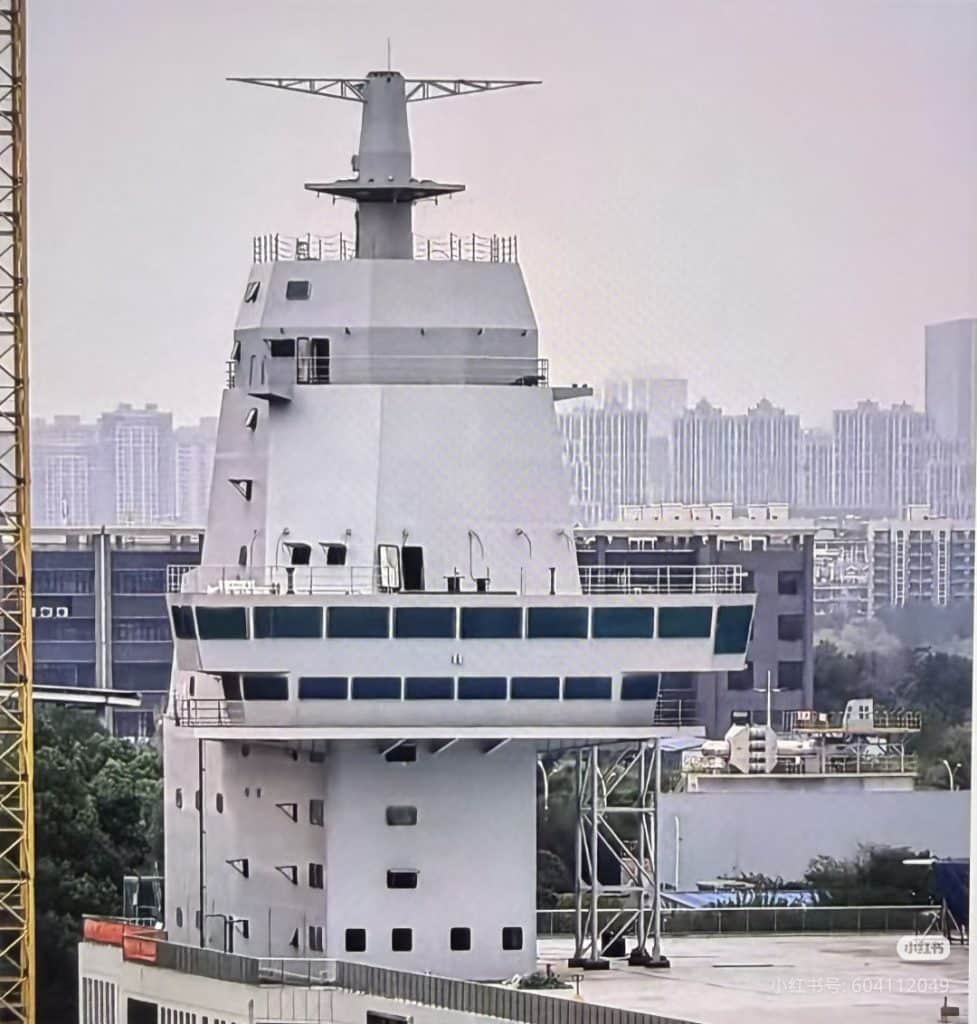The Chinese Navy (PLAN) on November 5 officially commissioned the third aircraft carrier, Fujian (18) into active service. High profile officials including paramount leader Xi Jinping attended the ceremony at Sanya Naval Base on the island of Sanya in the South China Sea.
The event at Sanya marks a high point in a journey spanning roughly eight years since the carrier started observed construction in Shanghai. First modules for the new ship appeared at builder Jiangnan in early 2018. The yard launched the carrier on June 17, 2022. The first sea trial occurred on May 1st, 2024. Since then, the largest vessel in the Chinese Navy has undertaken eight more sea trials, culminating in her arrival at Sanya in September this year.
The commissioning indicates that the ship named after the southeastern Chinese province across from Taiwan will operate under the PLA Southern Theatre Command (STC). Aircraft carrier Shandong was also present at the ceremony, together with a Type 075 amphibious assault carrier, likely the fourth vessel of the class, and numerous other combatants.
Xi Jinping with officials of the Chinese Navy and sailors of Fujian at the ceremony in Sanya on November 5. Image Chinese state media.
Known initially as “Type 003”, Fujian is the third operational aircraft carrier after Liaoning (16) and Shandong (17). The first two carriers entered service in September 2012, and December 2019, respectively. The new ship is also the first Chinese supercarrier, an informal designation for carriers exceeding 80,000 tons. Furthermore Fujian is the first such vessel equipped with electromagnetic catapults for PLAN. The service in turn has become the second navy after the United States to operate a carrier with electro-magnetic (EM) type catapults.
The commissioning also marks twenty years since Liaoning, then former Soviet carrier Varyag, was towed into a drydock in Dalian. There, at the eponymous shipbuilder, the incomplete vessel commenced her refurbishment for service with the Chinese Navy seven years later.
More work ahead before new carrier is operational.
Commissioning marks the milestone, when Fujian will officially commence operating under PLAN command. However, the event nevertheless does not signify an end to testing and shakedown cruises. Aircraft carriers represent a complex ecosystem of embarked aviation and the countless subsystems supporting the functionality of a mobile airbase. The nature of these largest military vessels implies a time-consuming process working up to operational capability.
The airwing display on Fujian at her commissioning included all relevant types, such as J-15T, J-35, KJ-600 and Z-20. Image via X social media channel, originally Chinese state media.
China has now accumulated significant operational experience with their first two carriers. However, Fujian also represents a further evolution and dramatic technological improvement over the Kuznetsov-type STOBAR carriers. As such, the new supercarrier will spend the next several years working up to full operational capability.
Further testing will involve increasingly increasing utilisation of the electromagnetic launch and recovery gear onboard. Other aspects would be certification of supporting systems such as weapons and fuel supply and verification of operational procedures.
New carrier also introduces new, more capable airwing.
Naval News has in the past reported extensively about the Chinese aircraft carrier program, and outlined relevant and observed operational characteristics of Fujian. In addition to fielding several new technologies on the vessel itself, the carrier will also operate a fundamentally improved airwing.
Embarked carrier aviation includes the catapult-capable J-15T multirole fighter jet, the J-15DT electronic warfare aircraft, the J-35 next generation fighter jet, and the KJ-600 airborne early warning aircraft. The combination of these three basic types in particular represents a quantum leap in capability over the previous two carriers Liaoning and Shandong. Assisted by catapult launch, each type will provide a jump in operational range, payloads and awareness to the Chinese Navy.
In addition, the rotary airwing will also see significant modernisation, with utility and ASW variants of the Z-20 helicopter as prominent examples.
Xi Jinping with crew of Fujian in front of a Z-20F ASW helicopter, notably armed with antiship missiles. Image X social media, originally Chinese state media.
The more diverse airwing underscores an ambition for PLAN to reach further into the Pacific Ocean and adjacent areas. As the first carrier of this type, Fujian will also serve in a significant training capacity. The ship will enable additional growth and seasoning for PLAN naval aviation in utilising these new weapon systems.
More carriers coming, in time.
Further Chinese aircraft carriers are not a question of if, but rather when. A fourth vessel is ostensibly under construction in Dalian at the eponymous shipbuilder that previously saw through completion of Liaoning and Shandong.
Definitive proof of its existence remains pending, owing to the very early state of construction, and scarce communication from Chinese authorities on the subject. Considering the construction pace for Fujian, more certainty over exact characteristics of the notional Type 004 should emerge in 2026.
Land-based carrier mockup in Wuhan, presumably displaying island configuration for the fourth aircraft carrier. The same facility previously featured similar mockups for Shandong and Fujian. Image via Sinodefenceforum.
Notable question marks concern the type of propulsion, speculated to be a nuclear powered design. Additionally, Type 004 will plausibly depart more strongly from the Kuznetsov-type hull which Fujian still features owing to risk reduction and rapid development. Detailed characteristics, however, remain fully speculative until more imagery substantiates any related assumptions.
A naval force transformed.
For now, the commissioning of the aircraft carrier Fujian into the active fleet underscores the transformation of the Chinese Navy into a true blue water force. The service stands second only to the United States both in the quantity of carriers it operates, and the operational capability of its naval aviation. The event represents the most notable benchmark in two decades of rapid modernisation for PLAN.
However, from a Chinese naval point of view, this accomplishment likely only heralds more significant transformation. Further substantial change will particularly affect overall fleet size and related reach. By the time the Chinese People’s Republic approaches their centenary, another 24 years in the future, in 2049, PLAN may have completed this journey.





